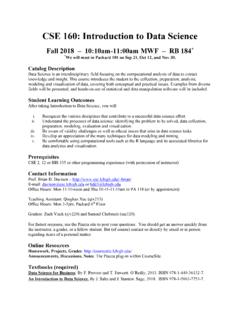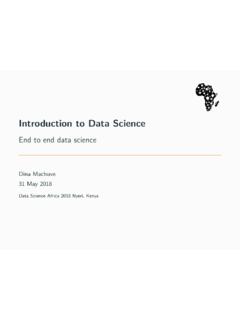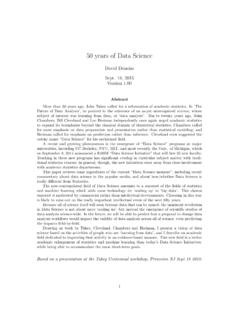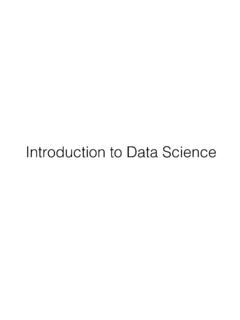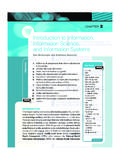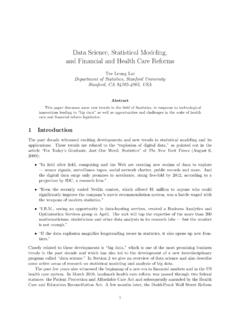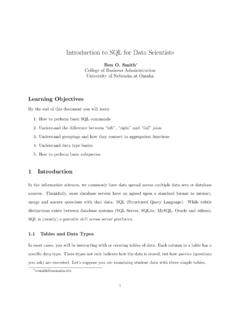Transcription of Introduction: Mind Over Data
1 The Book of Why: The New Science of Cause and Effect Pearl and Mackenzie 1 introduction : mind over data Every science that has thriven has thriven upon its own symbols. Augustus de Morgan (1864)This book tells the story of a science that has changed the way we distinguish facts from fiction, and yet has remained under the radar of the general public. The consequences of the new science are already impacting crucial facets of our lives and have the potential to affect more, from the development of new drugs to the control of economic policies, from education and robotics to gun control and global warming. Remarkably, despite the apparent diversity and incommensurability of these problem areas, the new science embraces them all under a unified methodological framework that was practically non-existent two decades ago.
2 The new science does not have a fancy name: I call it simply "causal inference," as do many of my colleagues. Nor is it particularly high-tech. The ideal technology that causal inference strives to emulate is in our own mind . Some tens of thousands of years ago, humans began to realize that certain things cause other things, and that tinkering with the former could change the latter. No other species grasps this, certainly not to the extent that we do. From this discovery came organized societies, then towns and cities, and eventually the science-based and technology-based civilization we enjoy today. All because we asked a simple question: "Why?" Causal inference is all about taking this question seriously. It posits that the human brain is the most advanced tool ever devised for managing causes and effects.
3 Our brains store an incredible amount of causal knowledge which, supplemented by data , could be harnessed to answer some of the most pressing questions of our time. More ambitiously, once we really understand the logic behind causal thinking, we could emulate it on modern computers and Unedited working copy, do not Book of Why: The New Science of Cause and Effect Pearl and Mackenzie 2 create an "artificial scientist. This would be a smart robot that discovers yet unknown phenomena, finds explanations to pending scientific dilemmas, designs new experiments and continually extracts more causal knowledge from the environment. But before we can venture to speculate on such futuristic developments, it is important to understand the achievements that causal inference has tallied thus far.
4 We will explore the way that it has transformed the thinking of scientists in almost every data -informed discipline, and how it is about to change our lives. The new science addresses seemingly straightforward questions like these: How effective is a given treatment in preventing a disease? Did the new tax law cause our sales to go up, or was it our advertising campaign? What is the health-care cost attributable to obesity? Can hiring records prove an employer is guilty of sex discrimination? I m about to quit my job, should I? The common feature of these questions is that they are all concerned with cause-and-effect relationships. We can recognize them through words such as preventing , cause, attributable to , discrimination and should I.
5 Such words are common in everyday language, and our society constantly demands answers to such questions. Yet until very recently science gave us no means even to articulate them, let alone answer them. By far the most important contribution of causal inference to mankind has been to turn this scientific neglect into a thing of the past. Causal inference has spawned a simple mathematical language to articulate causal relationships that we know as well as those we wish to find out about. The ability to express this information in mathematical form has unleashed a wealth of powerful and principled methods for combining our knowledge with data and answering causal questions like the five above. The Book of Why: The New Science of Cause and Effect Pearl and Mackenzie 3 I have been lucky to be part of this scientific development for the past quarter of a century.
6 I have watched its progress take shape in students cubicles and research laboratories, and I have heard its breakthroughs resonate in somber scientific conferences, far from the limelight of public attention. Now, as we enter the era of strong artificial intelligence, and many tout the endless possibilities of Big data and deep learning, I find it timely and exciting to present to the reader some of the most adventurous paths that the new science is taking, the way it impacts data science, and the many ways in which it will change our lives in the 21st century. When you hear me describe these achievements as a "new science," you may be skeptical. You may even ask: "Why hasn't this been done a long time ago?" Say when Virgil first proclaimed, "Lucky is he who has been able to understand the causes of things" (29 BC).
7 Or when the founders of modern statistics, Francis Galton and Karl Pearson, first discovered that population data can shed light on scientific questions. There is a long tale behind their unfortunate failure to embrace causation at this juncture, which we will tell in the historical sections of this book. But the most serious impediment, in my opinion, has been the fundamental gap between the vocabulary in which causal questions are cast and the traditional vocabulary in which scientific theories are communicated. To appreciate the depth of this gap, imagine the difficulties that a scientist would face in trying to express some obvious causal relationships, say that the barometer reading B tracks the atmospheric pressure P.
8 We can easily write down this relationship in an equation such as B = kP, where k is some constant of proportionality. The rules of algebra now permit us to rewrite this same equation in a wild variety of forms, for example, P =B/k, k =B/P, or B kP = 0. They all mean the same thing that if we know any two of the three quantities, the third is determined. None of the letters, k, B, P is in any mathematical way privileged over any of the others. How then can we express our strong conviction that it is the pressure that causes the barometer to The Book of Why: The New Science of Cause and Effect Pearl and Mackenzie 4 change and not the other way around? And if we cannot express even this, how can we hope to express the many other causal convictions that do not have mathematical formulas, such as The rooster s crow does not cause the sun to rise?
9 My college professors could not do it and never complained. I would be willing to bet that none of yours ever did either. We now understand why: Never were they shown a mathematical language of causes, nor were they shown its benefits. It is in fact an indictment of science that it has neglected to develop such a language for so many generations. Everyone knows that flipping a switch will cause a light to turn on or off, or that a hot, sultry summer afternoon will cause sales to go up at the local ice cream parlor. Why then have scientists not captured such obvious facts in formulas, as they did with the basic laws of optics, mechanics, or geometry? Why have they allowed these facts to languish in bare intuition, deprived of mathematical tools that have enabled other branches of science to flourish and mature?
10 Part of the answer is that scientific tools are developed to meet scientific needs. Precisely because we are so good in handling questions about switches, ice cream, and barometers, it was not obvious that we needed special mathematical machinery to handle them. But, as scientific curiosity increased, and causal questions were posed in complex legal, business, medical and policy-making situations, we found ourselves lacking the tools and principles that mature science should provide. Belated awakenings of this sort are not uncommon in science. For example, until about 400 years ago, people were quite happy with their natural ability to manage the uncertainties in daily life, from crossing a street to risking a fist fight.

